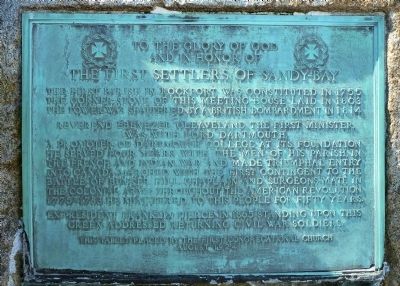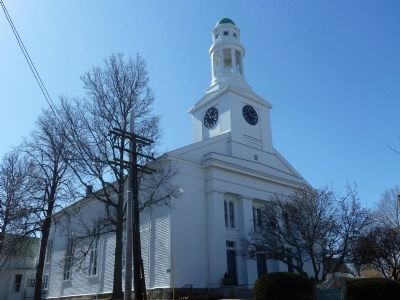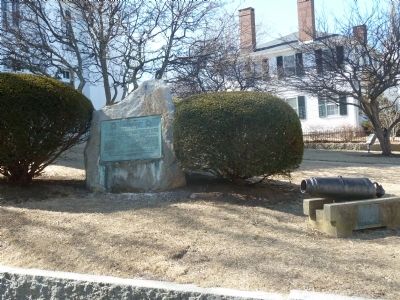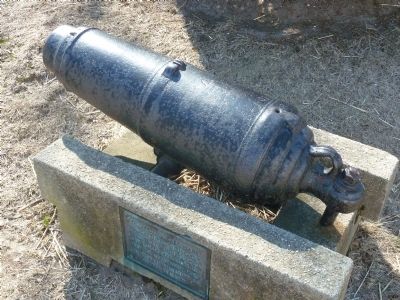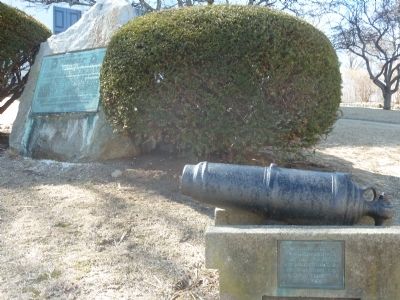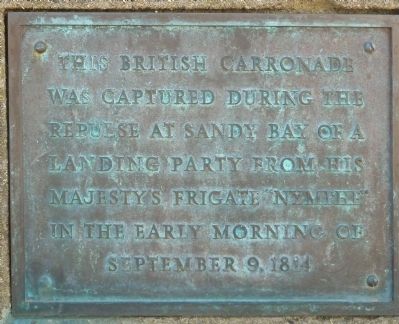Rockport in Essex County, Massachusetts — The American Northeast (New England)
The First Settlers of Sandy Bay
The First Parish in Rockport was constituted in 1755.
The corner stone of this meeting house laid in 1803.
The tower was shattered by a British bombardment in 1814.
Reverend Ebenezer Cleaveland the first minister, was with Lord Dartmouth, a promoter of Dartmouth College at its foundation. He served four years with the men of his parish, in the French and Indian War and made triumphal entry into Canada, marched with the first contingent to the Battle of Bunker Hill, chaplain and surgeons-mate in the Colonial Army throughout the American Revolution 1775 - 1783 he ministered to this people for fifty years.
Ex-president Franklin Pierce in 1865 standing upon this green addressed returning Civil War soldiers.
This tablet placed by the First Congregational Church August 1924
Erected 1924.
Topics and series. This historical marker is listed in these topic lists: Churches & Religion • Colonial Era • War, US Civil • War, US Revolutionary. In addition, it is included in the Former U.S. Presidents: #14 Franklin Pierce series list. A significant historical year for this entry is 1755.
Location. 42° 39.488′ N, 70° 37.131′ W. Marker is in Rockport, Massachusetts, in Essex County. Marker is on School Street. Touch for map. Marker is at or near this postal address: 12 School Street, Rockport MA 01966, United States of America. Touch for directions.
Other nearby markers. At least 8 other markers are within walking distance of this marker. First Congregational Church of Rockport Steeple Rehabilitation (a few steps from this marker); Bear Skin Neck (about 600 feet away, measured in a direct line); Rockport World War I & II Memorial (about 700 feet away); Revolutionary War Unknown Soldiers Grave Marker (about 700 feet away); Harvey Park (about 800 feet away); Old First Parish Burying Ground (about 800 feet away); First Settler (approx. ¼ mile away); Cannon from the U.S.S. Constitution (approx. ¼ mile away). Touch for a list and map of all markers in Rockport.
More about this marker. This is a bronze plaque mounted on a granite rock.
Next to this marker is a captured British cannon with the follow inscription on a brass plaque:
This British carronade was captured during the repulse at Sandy Bay of a landing party from His Majesty's frigate "Nymphe" in the early morning of September 9, 1814.
Credits. This page was last revised on June 16, 2016. It was originally submitted on April 21, 2014, by Larry Wilson of Wareham, Massachusetts. This page has been viewed 758 times since then and 22 times this year. Photos: 1, 2, 3, 4, 5, 6. submitted on April 21, 2014, by Larry Wilson of Wareham, Massachusetts. • Bill Pfingsten was the editor who published this page.
